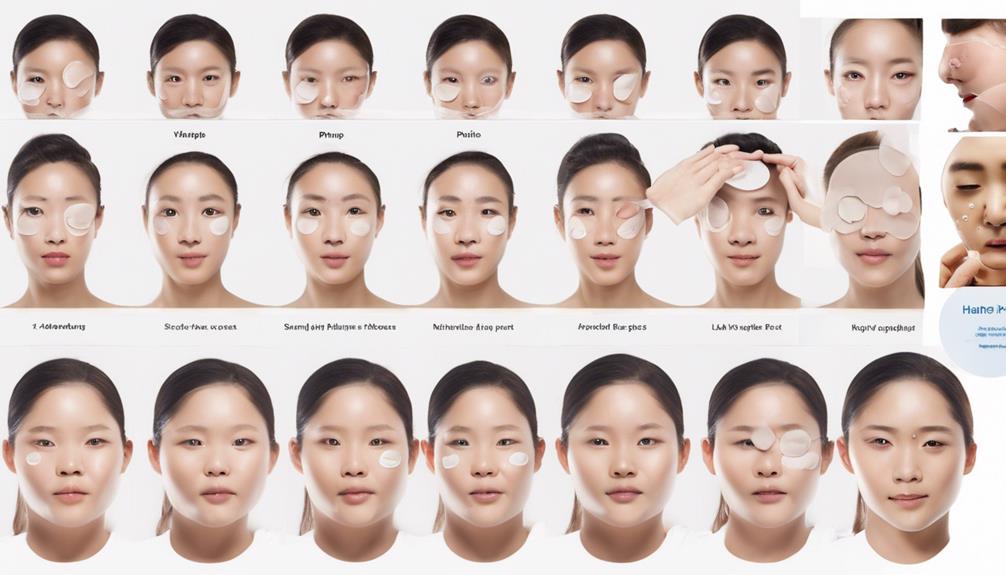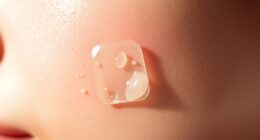To get the best results, leave a pimple patch on for 6-8 hours for whiteheads. If you’re dealing with larger blemishes or cystic acne, it’s fine to keep it on for up to 12 hours, or even 24 with certain patches. Overnight use is especially effective, helping to draw out impurities and reduce redness while you sleep. Remember, a white patch means it’s time to remove it. There are more timing tips you’ll want to know!
Key Takeaways
- For whiteheads, wear the patch for 6-8 hours; larger cystic acne can be worn for up to 12 hours.
- Some patches are designed for extended wear, lasting up to 24 hours, for stubborn blemishes.
- Overnight use accelerates healing by drawing out impurities and reducing redness by morning.
- Regularly check the patch; replace if it becomes saturated or starts peeling.
- Consider your skin type and the severity of the blemish to determine the ideal wear time.
Understanding Pimple Patches: What They Are and How They Work

Pimple patches are an innovative solution designed to tackle acne effectively. These patches come in various types, including hydrocolloid, medicated, and microneedle options, each catering to different skin needs. Their primary purpose is to treat acne by protecting the affected area and reducing the risk of infection. Made from translucent or skin-toned materials, they offer a discreet way to manage breakouts throughout the day. Hydrocolloid patches absorb excess fluid and impurities, while medicated patches often include active ingredients like salicylic acid or tea tree oil. They act as a barrier against dirt and bacteria, preventing further irritation that could lead to scarring. Pimple patches are particularly effective for treating individual, surface-level pimples, helping to reduce inflammation and limit the urge to pick at the skin.
Recommended Duration for Optimal Results

When using pimple patches, knowing how long to keep them on can greatly enhance their effectiveness. For best results, aim to wear your patch for 6-8 hours. If you’re dealing with whiteheads, this duration works well.
However, for larger blemishes or cystic acne, you might want to leave the patch on longer, up to 12 hours overnight. Some patches can even be worn for up to 24 hours, depending on the formulation and severity of your acne. This extended wear can be particularly beneficial for cysts or aggressive spots.
Always look for signs like the patch turning white, which indicates it’s absorbed impurities and should be removed.
Benefits of Overnight Use
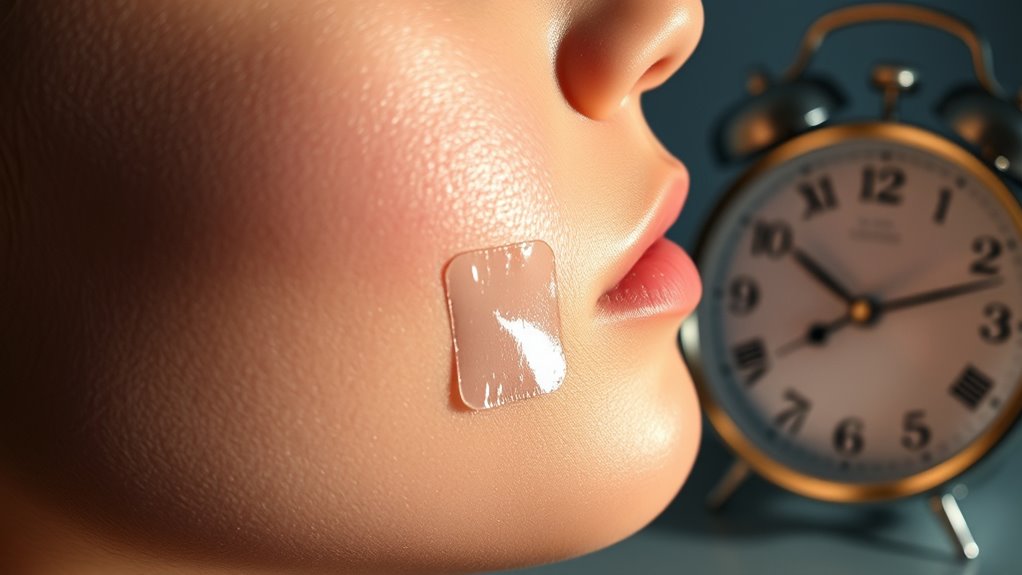
Using pimple patches overnight offers significant benefits, especially for those looking to speed up healing. They work by continuously drawing out impurities and excess fluids, which accelerates recovery. Plus, the patches act as a barrier, preventing you from picking at blemishes, ultimately reducing the risk of scarring and infection. You’ll notice reduced redness and swelling by morning, thanks to active ingredients like salicylic acid that help calm inflammation. Additionally, the recommended wear time for standard patches aligns with the natural repair process of your skin, enhancing their effectiveness while you sleep.
These patches also protect your skin from environmental irritants, creating a cleaner healing environment. Furthermore, they are often made with hydrocolloid technology, which helps to absorb moisture and promote healing. Designed for comfort, they allow you to sleep uninterrupted while treating your skin. With visible results by morning, you’ll feel more confident and motivated to maintain your skincare routine.
Extended Wear: When and Why to Use It
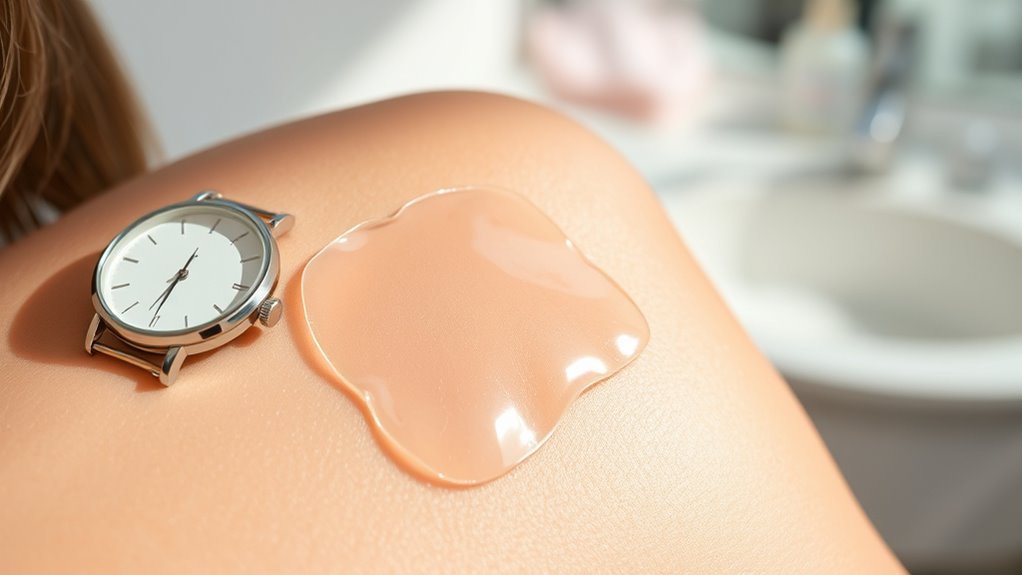
For those dealing with stubborn blemishes, extended wear of pimple patches can be a game changer. Leaving a patch on for more than the standard 6 to 8 hours, often up to 24 hours, helps tackle deeper pimples and reduce redness over time. These thinner, discreet patches are perfect for daytime use, providing a protective barrier against bacteria. Regular checks are essential; if a patch becomes saturated or starts to peel, replace it to maintain effectiveness. This method also prevents you from picking at the pimple, minimizing scarring risk. Additionally, using a patch allows for effective absorption of impurities, making extended wear a convenient option for your busy schedule.
Factors That Influence Timing Decisions
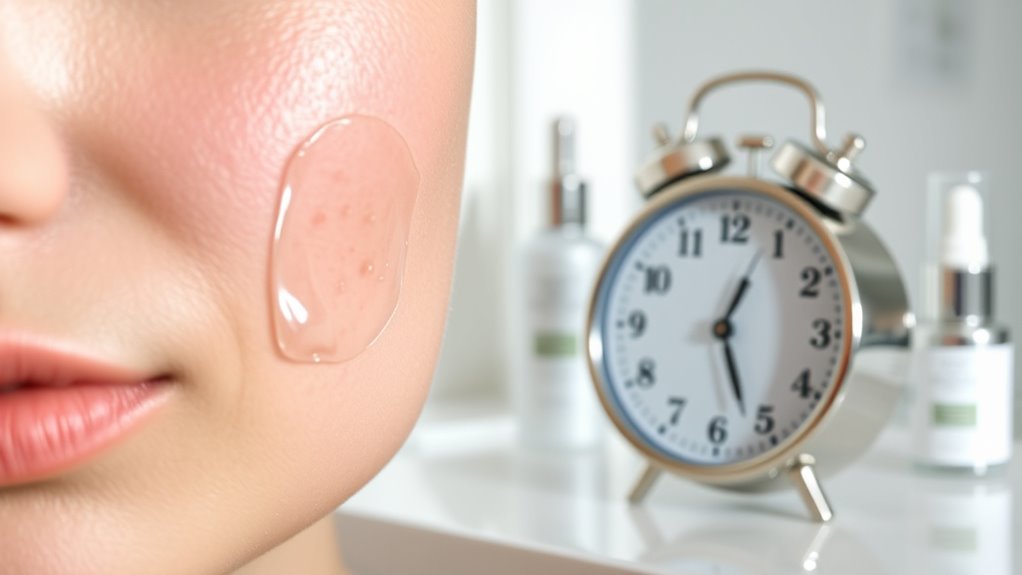
Understanding the factors that influence how long you should leave a pimple patch on is essential for maximizing its effectiveness.
The type of acne matters; whiteheads typically need around 6-8 hours, while cystic pimples may require longer wear for inflammation reduction. Additionally, pimple patches are effective for specific types of blemishes, particularly white heads, which underscores the importance of targeting the right type of acne. Many patches, like the Starface Acne Patches, are designed specifically to address various acne types and enhance the treatment experience.
Your skin type plays a role too—oily skin can affect patch adhesion, while sensitive skin might need shorter durations to avoid irritation.
The severity of the blemish also impacts timing; larger pimples benefit from extended wear. Using patches that contain active ingredients, such as salicylic acid, can further enhance their effectiveness against stubborn blemishes.
Additionally, the patch type and ingredients matter; hydrocolloid patches work well for moisture absorption, whereas those infused with active ingredients might irritate if left on too long.
Evaluating these factors can help you determine the ideal duration for your pimple patch.
Tips to Maximize the Effectiveness of Pimple Patches

To maximize the effectiveness of pimple patches, it’s crucial to choose the right type and prepare your skin properly. Hydrocolloid patches work best for whiteheads and oil-related breakouts, while medicated patches are ideal for inflamed pimples.
Start by cleansing your skin gently with a non-comedogenic cleanser, then pat it dry to guarantee proper adhesion. Avoid using heavy products that can hinder the patch’s stickiness. Proper timing is essential, as applying patches when a pimple has surfaced increases the chances of noticeable results by morning.
When applying, center the patch over the blemish and press down firmly. For best results, wear the patch for the recommended time, usually 6–8 hours. Make sure to check it regularly and replace it if it loses adhesion or becomes saturated.
Finally, maintain hygiene by washing your hands before and after application.
Frequently Asked Questions
Can I Apply Makeup Over a Pimple Patch?
Yes, you can apply makeup over a pimple patch!
Just make sure to use a thin layer of makeup to avoid making the patch too noticeable. Apply it gently and opt for a matte finish to blend seamlessly.
Remember, using hydrocolloid patches provides added protection against bacteria while you wear makeup.
Just be cautious with heavy products, as they can affect the patch’s adherence and effectiveness. Keep it light for the best results!
Are Pimple Patches Safe for Sensitive Skin?
Think of pimple patches as a gentle shield protecting your skin. They can be safe for sensitive skin, but you should tread carefully.
Start with non-medicated hydrocolloid patches to minimize irritation. Always perform a patch test before using a new product, and limit initial wear time to see how your skin reacts.
If you notice redness or discomfort, it’s best to remove the patch and consult a dermatologist for tailored advice.
How Do I Choose the Right Pimple Patch?
When you’re choosing the right pimple patch, consider your skin type and the specific blemish.
For sensitive skin, go for hypoallergenic patches. If you have oily skin, look for patches with salicylic acid.
Hydrocolloid patches work great for deeper cystic pimples, while microneedle patches deliver active ingredients more effectively.
Make certain the patch size matches your pimple, and remember to cleanse your skin before application for the best results.
Can I Reuse Pimple Patches?
You can’t reuse pimple patches. Once they’ve absorbed oil and pus, they lose their effectiveness and can introduce bacteria back into your skin.
Reusing them might lead to infections or irritation, which you definitely want to avoid. After use, make sure to discard them properly to maintain hygiene.
Stick to fresh patches for the best results, ensuring your skin stays healthy and clear while treating those pesky breakouts.
What Happens if I Leave a Patch on Too Long?
If you leave a pimple patch on too long, you risk skin irritation, like redness and itching.
Your skin might peel or dry out, especially if the adhesive gets too sticky. The patch can lose effectiveness once saturated, trapping bacteria and potentially causing new breakouts.
Additionally, prolonged use can compromise your skin barrier and increase infection risks. Always listen to your skin, and remove the patch when it shows signs of saturation.
Conclusion
In the quest for clearer skin, timing truly is everything. By knowing how long to leave your pimple patch on, you not only maximize its effectiveness but also reveal a world of skin confidence. It’s funny how a little patch can make such a big difference, isn’t it? So, whether you’re applying it overnight or for an extended period, you’re one step closer to saying goodbye to those pesky pimples. Trust the process, and let your skin shine!


